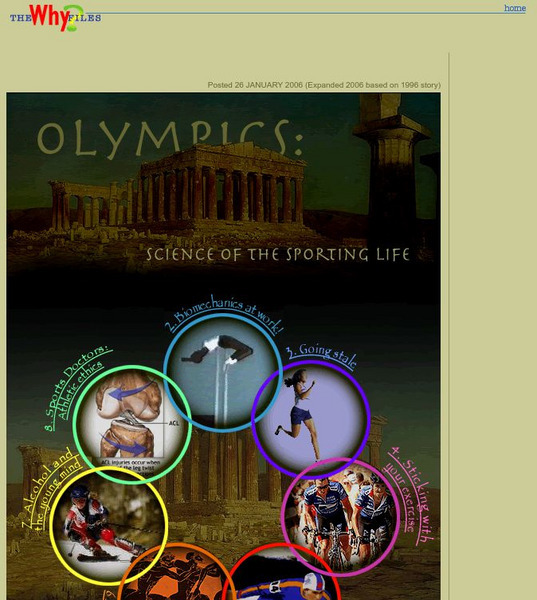National Energy Education Development Project
Exploring Transportation
Did you know horsepower is actually based on the power of a horse? 60 horse power is the equivalent of being pulled by a team of 60 horses! Viewers will learn other interesting facts like this from a presentation that begins with the...
Royal Society of Chemistry
The 400m Event—Chemistry and Sport
How do Olympic runners succeed in physically demanding events like the 400-meter dash? Physiology scholars explore the relationship between acids, bases, and the muscular system through a scenario-driven activity. The activity focuses on...
Curated OER
Olympic Solar Energy
Students use cardboard and aluminum foil to construct a solar oven that concentrates enough sunlight to cook a hotdog. They review the history and use of solar energy in relation to the Olympics.
American Museum of Natural History
What's This? Gold
Cell phones are likely made of gold—at least part of them! An interesting lesson explains the conventional and not-so-conventional uses of the popular element gold. From the Inca empire to modern-day technology, learners discover gold...
National Energy Education Development Project
Exploring Hybrid School Bus Technology
The color School Bus Yellow was created in 1939 because science had proven peripheral vision detects yellow 1.24 times faster than other colors. Young scientists explore modern school bus transportation options and then discuss the...
Curated OER
Here and There: Discovering Communities Through the Olympic Torch Relay
Students compare their hometowns to the towns on the Olympic Torch Relay and complete multi-curricular activities for the lesson. In this Olympics lesson, students complete math, geography, science, and history activities to learn about...
Curated OER
Eyes in the Sky
Students examine the use of satellites. In this research lesson, students discuss the history of satellites and how we use the information today. They will conduct interviews with older adults who have lived in the changing times from...
Curated OER
Salmon Vs. Dams: the Dam Removal Debate on the Elwha River
Young scholars role-play a meeting of the Elwha River council in which they present opposing views to council members on hydroelectric power and salmon fisheries resources. They brainstorm possible conflicts between various people in...
Curated OER
Phat Shredders and Phony Phorces: Snowboarding, Winter Sports, Olympics, Sport Safety, Science, Physics
Students study about the history, physical science, and safety issues involved in snowboarding.
Curated OER
Olympic Snowboarding Village
Students adopt a country to research and tour the country online. They plan a trip from Nagano back home to their country.
Curated OER
Lunar Field Trip
Students take a virtual tour on Google Moon of what human life would be like on the moon. In this moon lesson plan, students also compose web diagrams, make charts, make a time line, investigate problems, and more.
Curated OER
Olympic Line Graphs
Sixth graders examine how to make line graphs. In this Olympic line graph lesson students make line graphs and search the given Internet sites to find data on their summer Olympic Game.
Curated OER
Salmon vs. Dams: The Dam Removal Debate on the Elwha River
Students use roll playing to discuss the merits of tearing down these dams so that the Elwha River can run free. The activity is presented in the form of a council meeting to encourage students to try to build consensus in finding...
Curated OER
Out and About: The Science of Sport
Students take a closer look at sports science. In this hands-on learning lesson, students may visit the Science Museum, the Life Science Centre, or the Wimbledon Lawn Tennis Museum online or in-person to discover details related to the...
Curated OER
Natural Disaster
Describe how plate tectonics account for various land formations. Learners discuss different marine sanctuaries and create a poster about tectonic activity in these areas. They share their posters with the class.
Curated OER
Canoe and Kayak
Students explore canoes and kayaks. In this canoe and kayak lesson, students research the history, parts, and sport of the canoe and kayak. Students then practice how to use a paddle for each boat, and go on a field trip in order...
University of Wisconsin
The Why Files: Olympics: Science of the Sporting Life
When the Winter Olympics begin we can study the science of sports: biomechanics, figure skating, high jumping, mental preparation, alcohol and athletes, sports doctors, staleness, and training in the ancient Olympics.
A&E Television
History.com: 2021 Events
2021 is nearly history. Take a look back at a year that saw political turmoil, the distribution of COVID-19 vaccines, an unusual Olympic Games, devastating natural disasters, advances in space exploration and more.
Smithsonian Institution
National Museum of Natural History: American Mammals: Olympic Marmot
Olympic Marmots are highly social, living in groups made up of an adult male, one or more adult females, two-year-olds, yearlings, and young. Their diet consists of grasses and sedges, with flowering plants in season. Learn more about...
Smithsonian Institution
National Museum of Natural History: American Mammals: Townsend's Mole
The largest moles in North America, weighing in at 100 - 171 grams, Townsend's Moles live only in the lowlands on the western side of the Cascade Mountains, from northwestern California to extreme southwestern British Columbia. One...



















